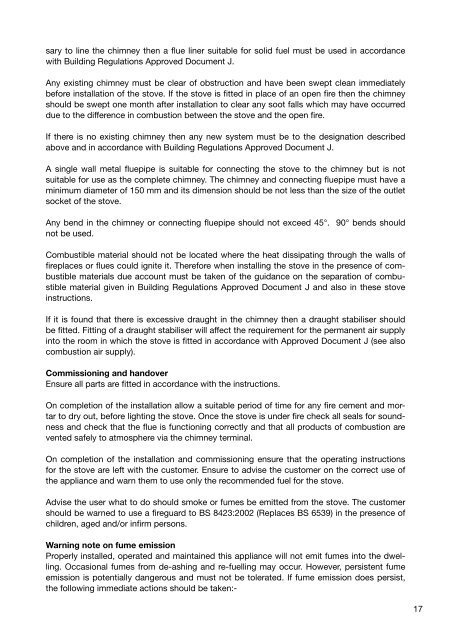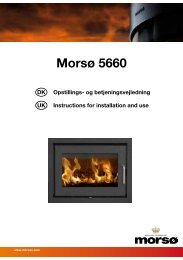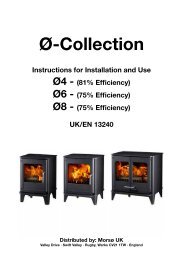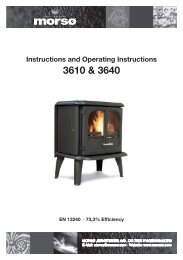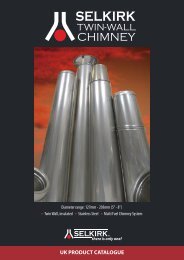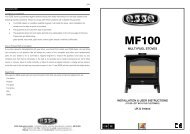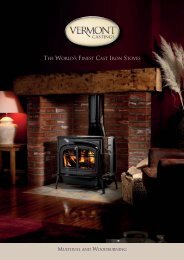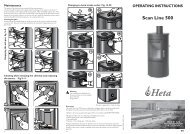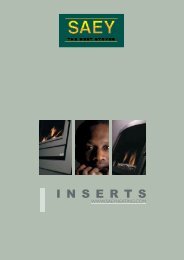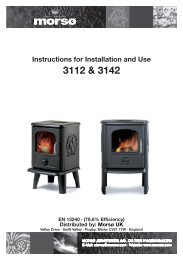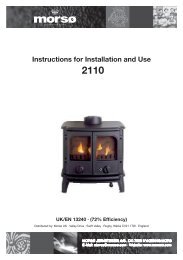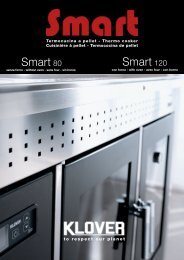View - Stoves Online
View - Stoves Online
View - Stoves Online
Create successful ePaper yourself
Turn your PDF publications into a flip-book with our unique Google optimized e-Paper software.
sary to line the chimney then a flue liner suitable for solid fuel must be used in accordance<br />
with Building Regulations Approved Document J.<br />
Any existing chimney must be clear of obstruction and have been swept clean immediately<br />
before installation of the stove. If the stove is fitted in place of an open fire then the chimney<br />
should be swept one month after installation to clear any soot falls which may have occurred<br />
due to the difference in combustion between the stove and the open fire.<br />
If there is no existing chimney then any new system must be to the designation described<br />
above and in accordance with Building Regulations Approved Document J.<br />
A single wall metal fluepipe is suitable for connecting the stove to the chimney but is not<br />
suitable for use as the complete chimney. The chimney and connecting fluepipe must have a<br />
minimum diameter of 150 mm and its dimension should be not less than the size of the outlet<br />
socket of the stove.<br />
Any bend in the chimney or connecting fluepipe should not exceed 45°. 90° bends should<br />
not be used.<br />
Combustible material should not be located where the heat dissipating through the walls of<br />
fireplaces or flues could ignite it. Therefore when installing the stove in the presence of combustible<br />
materials due account must be taken of the guidance on the separation of combustible<br />
material given in Building Regulations Approved Document J and also in these stove<br />
instructions.<br />
If it is found that there is excessive draught in the chimney then a draught stabiliser should<br />
be fitted. Fitting of a draught stabiliser will affect the requirement for the permanent air supply<br />
into the room in which the stove is fitted in accordance with Approved Document J (see also<br />
combustion air supply).<br />
Commissioning and handover<br />
Ensure all parts are fitted in accordance with the instructions.<br />
On completion of the installation allow a suitable period of time for any fire cement and mortar<br />
to dry out, before lighting the stove. Once the stove is under fire check all seals for soundness<br />
and check that the flue is functioning correctly and that all products of combustion are<br />
vented safely to atmosphere via the chimney terminal.<br />
On completion of the installation and commissioning ensure that the operating instructions<br />
for the stove are left with the customer. Ensure to advise the customer on the correct use of<br />
the appliance and warn them to use only the recommended fuel for the stove.<br />
Advise the user what to do should smoke or fumes be emitted from the stove. The customer<br />
should be warned to use a fireguard to BS 8423:2002 (Replaces BS 6539) in the presence of<br />
children, aged and/or infirm persons.<br />
Warning note on fume emission<br />
Properly installed, operated and maintained this appliance will not emit fumes into the dwelling.<br />
Occasional fumes from de-ashing and re-fuelling may occur. However, persistent fume<br />
emission is potentially dangerous and must not be tolerated. If fume emission does persist,<br />
the following immediate actions should be taken:-<br />
17


